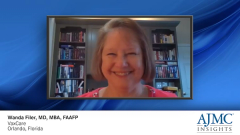
RSV Outcomes in Infant, Pediatric, and Adult Patient Populations
Wanda Filer, MD, MBA, FAAFP, provides an overview of the potential outcomes for patients of all ages with RSV.
Wanda Filer, MD, MBA, FAAFP: RSV [respiratory syncytial virus] initially can cause typical head cold symptoms. It can cause a runny nose, which is probably what it is most known for. Initially, [patients have a] sore throat, fever, but eventually it can move down into the airway and they develop bronchitis, bronchiolitis, [and it affects] all the tubes associated with breathing. It can also lead to pneumonia or even respiratory failure. For children, you’ll see that they have very small airways. If those airways are infected and swollen, they have great difficulty breathing; they’re going to have some wheezing and difficulty with shortness of breath.
In adults, it can move downward, especially if it’s an older adult or an adult with underlying lung or cardiac problems. They are at very high risk of ending up needing to be on a ventilator to support them. The only treatment for RSV is support. We don’t have a medication, we don’t have an antibody against RSV, so it’s really supportive care, but unfortunately, especially in older adults, it can be fatal.
In early childhood, RSV infection can cause prolonged symptoms. Parents will tell you their child never had wheezing episodes until after they’ve had RSV. Indeed, some children will develop reactive airway disease, which we probably more commonly known as asthma. So even another cold another virus, a change in temperature, or exposure to pollen may make them much more susceptible to wheezing; even exercise can make them susceptible.
RSV costs the US millions of dollars, and people often don’t realize that. The hospitalization rates: 60,000 to 160,000 [adults] are hospitalized [each year]. Many of them end up in the intensive care unit; they may end up on ventilators. We’re talking about millions of dollars of expense, let alone in terms of human suffering. It’s the leading cause of hospitalizations in children 2 years and younger with bronchiolitis. This is a place where we can try to support these children but, again, having some way to prevent this would be ideal.
RSV is an equal opportunity offender. Patients who are having difficulty [with] social determinants of health, poverty, and transportation issues may have difficulty getting to medical care in a timely fashion. [Those who] are living in a crowded housing situation perhaps do not have adequate nutrition, and therefore their immune system may be assaulted, it may be weakened; those individuals are much more likely to develop problems with RSV. And those problems can lead to very severe consequences, including death.
Transcript edited for clarity.
Newsletter
Stay ahead of policy, cost, and value—subscribe to AJMC for expert insights at the intersection of clinical care and health economics.





























































